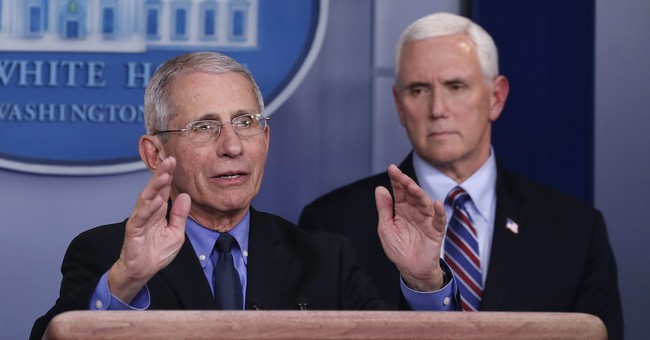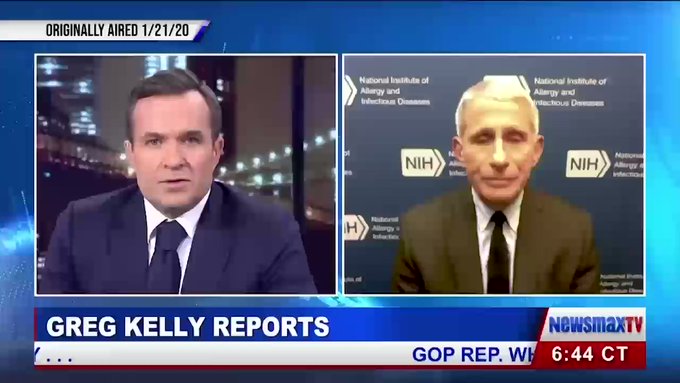Dr. Fauci in January indicated America does not have to worry about virus
Posted at 11:00 am on April 4, 2020 by Elizabeth Vaughn

Dr. Anthony Fauci, director of the National Institute of Allergy and Infectious Diseases, speaks about the coronavirus in the James Brady Briefing Room, Thursday, March 26, 2020, in Washington, as Vice President Mike Pence listens. (AP Photo/Alex Brandon)
Fox News‘ Brit Hume has posted a clip of Dr. Fauci speaking to News Max reporter Greg Kelly on January 21. Kelly addresses Fauci, “Bottom line. We don’t have to worry about this one, right?”
Fauci replies, “Well, obviously you need to take it seriously. And do the kinds of things that the CDC and the Department of Homeland Security are doing, but this is not a major threat for the people of the United States and this is not something that the citizens of the United States right now should be worried about.”
That’s what Trump was hearing from Dr. Fauci, an expert, a man who has served as the Director of the National Institute of Allergy and Infectious Diseases since 1984.
Greg Kelly Reports
Greg Kelly Reports
I yield to no one in admiration of Dr. Fauci. But this comment from January 21 should be kept in mind by those accusing anyone in the U.S. of failing to act in time against Covid 19. Watch it all the way through:
13.8K people are talking about this
Consider the following timeline of China’s actions in January. (Data from a recent post by my colleague, Streiff, which can be viewed here.)
Dec. 31:
- Wuhan health officials confirm 27 cases of illness and close a market they think is related to the virus’ spread.
- China tells the World Health Organization’s China office about the cases of an unknown illness.
Jan. 1: Wuhan Public Security Bureau brings in for questioning eight doctors who had posted information about the illness on WeChat.
- An official at the Hubei Provincial Health Commission orders labs, which had already determined that the novel virus was similar to SARS, to stop testing samples and to destroy existing samples.
Jan. 2: Chinese researchers map the new coronavirus’ complete genetic information. This information is not made public until Jan. 9.Jan. 7: Xi Jinping becomes involved in the response.Jan. 9: China announces it has mapped the coronavirus genome.Jan. 11–17: Important prescheduled CCP meeting held in Wuhan. During that time, the Wuhan Health Commission insists there are no new cases.Jan. 13: First coronavirus case reported in Thailand, the first known case outside China.Jan. 14: WHO announces Chinese authorities have seen “no clear evidence of human-to-human transmission of the novel coronavirus.”Jan. 15: The patient who becomes the first confirmed U.S. case leaves Wuhan and arrives in the U.S., carrying the coronavirus.Jan. 18:
- The Wuhan Health Commission announces four new cases.
- Annual Wuhan Lunar New Year banquet. Tens of thousands of people gathered for a potluck.
Jan. 19: Beijing sends epidemiologists to Wuhan.Jan. 20:
- The first case announced in South Korea.
- Zhong Nanshan, a top Chinese doctor who is helping to coordinate the coronavirus response, announces the virus can be passed between people.
So, Dr. Fauci, the man who has led the NIAID for 36 years says the coronavirus does not pose a threat to the people of the U.S. on January 21.
Prior to January 21, there was very little information coming out of China or The Who. China insisted there were no new cases. On January 21, we began to hear about their lockdowns. Additionally, the first person in the U.S. tested positive for the virus.
Jan. 21:
- The U.S. Centers for Disease Control and Prevention confirms the first coronavirus case in the United States.
- CCP flagship newspaper People’s Daily mentions the coronavirus epidemic and Xi’s actions to fight it for the first time.
- China’s top political commission in charge of law and order warns that “anyone who deliberately delays and hides the reporting of [virus] cases out of his or her own self-interest will be nailed on the pillar of shame for eternity.”
Jan. 23: Wuhan and three other cities are put on lockdown. Right around this time, approximately 5 million people leave the city without being screened for the illness.Jan. 24–30: China celebrates the Lunar New Year holiday. Hundreds of millions of people are in transit around the country as they visit relatives.Jan. 24: China extends the lockdown to cover 36 million people and starts to rapidly build a new hospital in Wuhan. From this point, very strict measures continue to be implemented around the country for the rest of the epidemic.
Trump officials had taken action prior to January 21, but began focusing intensely on combatting the virus once the new information was known. Here is a timeline of actions taken early on by the Trump Administration.
• Jan. 7: The CDC established a Wuhan virus incident management system .• Jan. 17: The CDC began implementing public health entry screening at the three U.S. airports that received the most travelers from Wuhan.• Jan. 20: Dr. Anthony Fauci, director of the National Institutes of Allergy and Infectious Diseases, announced efforts to develop a vaccine.• Jan. 21: The CDC activated its emergency operations center to provide support to the coronavirus response.• Jan. 31: President Trump declared a public health emergency, announced Chinese travel restrictions, and suspended entry into the U.S. for foreign nationals at risk of transmitting the virus.
What were the Democrats doing? Nancy Pelosi was debating over whether or not to send the Articles of Impeachment over to the Senate. She was trying to negotiate with Senate Majority Leader Mitch McConnell over the terms of the Senate trial. Once she realized she had no leverage, she submitted the Articles and focused her undivided attention on impeaching this “lawless, dangerous President.”
Enough said.


No comments:
Post a Comment